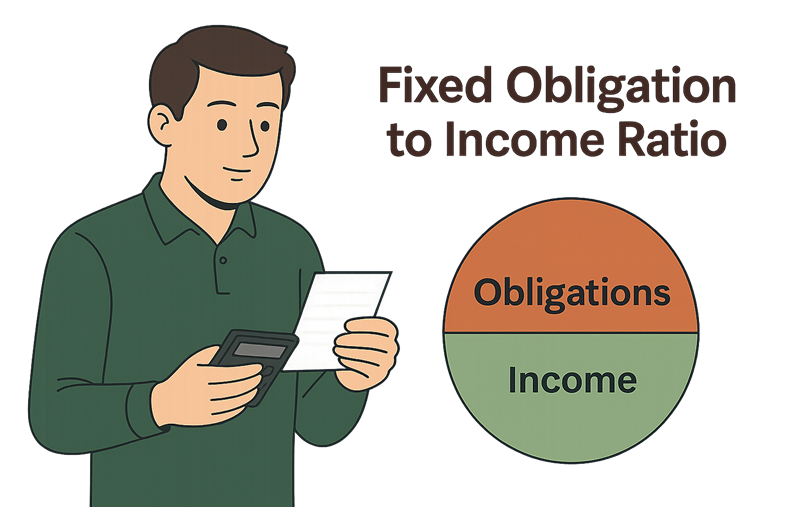

Did You Know?
We serve loans, the best way you can borrow

We serve loans, the best way you can borrow

Whether you need quick cash for medical bills or special occasions, getting a loan from a lender is not that simple when you are a beginner. Financial troubles may come without a warning. So, while you apply for a loan, you need to understand the basics. Talking about the basics, lenders always look at a few eligibility standards when you apply for loans. They include the credit score, income level, employment history, and current loans. That is where the discussion of FOIR comes in. The FOIR full form is Fixed Obligation to Income Ratio.
Let's find out everything about FOIR in simple terms so you can make better borrowing decisions and boost your approval chances.
Fixed Obligation to Income Ratio or FOIR measures how much of your monthly income goes toward paying existing debts and financial obligations. Lenders use this important number to check if you can handle another loan payment comfortably. The FOIR full form gives lenders a clear picture of your financial health and ability to manage additional debt.
Lenders thoroughly examine your income sources, credit history, current debts, as well as spending habits when you apply for a personal loan. They need to ensure you have the money left after paying existing obligations. This careful assessment helps them decide if you qualify for the loan amount you want.
The FOIR ratio typically should fall between 40% and 55% for good loan approval chances. A lower percentage means you have more disposable income available for new loan payments. Your financial obligations include existing loan EMIs, credit card bills, rent payments, and other regular financial commitments that cannot be easily changed.
Now that you know what is FOIR, let's learn how to calculate it yourself before applying for a loan.
Start by listing every fixed payment you make each month. This includes existing loan EMIs, credit card payments, rent, and other regular financial obligations you cannot avoid.
Add up all your income sources, including salary, rental income, dividends, or any other steady monthly earnings, before tax deductions.
The FOIR calculation formula is simple: divide your total monthly obligations by your monthly income and multiply by 100.
FOIR formula = (Total Monthly Obligations ÷ Monthly Income) × 100
The resulting percentage tells you how much of your income goes toward debt repayment. Lower percentages indicate better financial health and higher loan approval chances.
Let's look at a FOIR calculation with example: Suresh earns ₹60,000 per month. His existing obligations include a car loan EMI of ₹8,000, credit card payment of ₹5,000, and rent of ₹12,000. His total monthly obligations equal ₹25,000.
How to calculate FOIR: (₹25,000 ÷ ₹60,000) × 100 = 41.67%
Your FOIR score affects your financial life in many ways. Here's what different scores mean for you.
A low FOIR ratio shows excellent financial health. It means you spend less than 40% of your income on debt payments and have plenty left for savings and new loans.
Most lenders accept this range for loan approvals. You are managing your finances reasonably well. However, you must avoid taking on too much debt that might strain the budget.
A high ratio signals potential financial stress. Lenders might hesitate to approve your loan application since you already spend a significant portion of your income on existing obligations.
This danger zone indicates serious financial strain. Loan approval becomes extremely difficult, and you should focus on reducing current debts before applying for new loans.
Understanding your FOIR helps make better financial decisions. Here's why it matters:
Lenders use the FOIR calculator as a primary factor in deciding loan approval. A favourable ratio significantly increases your chances of getting the loan amount you need.
Your FOIR helps lenders assess default risk. Lower ratios indicate financial stability and make you a less risky borrower in the eyes of financial institutions.
Even if you qualify for a loan, your FOIR helps determine how much you can borrow. Better ratios often lead to higher approved loan amounts with better terms.
A good FOIR might help you secure lower interest rates. Lenders offer better rates to financially stable borrowers who pose less risk of defaulting on payments.
Your FOIR full form plays a crucial role in loan application results. Lenders feel confident about your repayment ability when they see a favourable ratio. A high ratio raises red flags about your financial health and might lead to loan rejection. Keeping your FOIR within acceptable limits ensures better loan terms, higher approved amounts, and faster processing times. Financial institutions prefer lending to those who can comfortably manage additional debt.
Improving your FOIR can boost loan approval chances. Try these effective strategies:
Focus on clearing high-interest debts first. Reducing your current obligations directly improves your FOIR and frees up income for new loans.
Look for ways to boost your earnings through side incomes or freelance work. Higher income with the same obligations improves your ratio.
Consider applying with a co-borrower who has a good income. This increases the total income considered for FOIR calculation and improves approval chances.
Taking too many loans simultaneously raises your FOIR. Space out your loan applications and focus on reducing existing debts before applying for new ones.
Restructuring existing loans with longer repayment periods can reduce your monthly EMIs and improve your FOIR despite paying more interest over time.
Different lenders have varying FOIR requirements based on their risk assessment models. Most banks and financial institutions prefer ratios between 40% and 55%, but this can change based on your income level, credit score, and loan type. A few lenders might accept higher ratios for high-net-worth individuals with good credit histories. Always check specific lender requirements before applying.
Understanding the FOIR full form helps make informed borrowing decisions. By maintaining a healthy ratio, you improve loan approval chances and get better terms. Remember that the FOIR calculation gives lenders insight into your financial health and repayment capacity. Focus on reducing existing debts and growing your income to maintain a favourable ratio. lendingplate offers personal loan solutions that consider your unique financial situation.
FOIR stands for Fixed Obligation to Income Ratio & shows what percentage of the monthly income goes toward paying the existing financial obligations. Note that lenders use the number to determine whether you will be able to handle another loan payment comfortably without monetary issues.
Most lenders prefer the FOIR ratio between 40% and 55% for loan approval. Keeping your ratio below 50% significantly improves your chances of getting approved quickly with better terms and lower interest rates.
FOIR requirements vary based on loan type. Home loans may accept higher ratios up to 55-65% since they are secured loans. Personal loans typically require lower ratios, around 40-50%, because they don't have collateral backing them up.
Yes, monthly rent payments count as fixed obligations when calculating your FOIR. Lenders include all regular financial commitments, including rent, existing loan EMIs, credit card payments, and other unavoidable monthly expenses in the calculation.
A high FOIR suggests most of your income already goes toward debt payments. This raises concerns about your ability to handle additional loan obligations. Lenders might reject your application or offer smaller loan amounts with higher interest rates.
Loan-to-Value (LTV) ratio measures the loan amount against the asset value for secured loans. FOIR measures your debt obligations against your income, regardless of loan type. Both ratios help lenders assess risk but from different perspectives.
You may improve the FOIR by paying off existing debts. You may also increase your income through additional sources or consolidate high-interest loans. At the same time, you can avoid new debt or extend the existing loan tenures to reduce monthly payments. Aim for a ratio below 50% for best results.
Download our personal loan app to apply for a personal loan. Get up to 2Lakhs* as a personal loan. Download Now!
Sign into avail a personal loan up to ₹ 2,50,000
Register to avail an instant loan in just a few minutes. Fulfil your financial needs with our loan and repay in easy EMIs.
Apply NowUnifinz Capital India Limited is a Non Banking Finance Company (NBFC) registered with the Reserve Bank of India (RBI). lendingplate is the brand name under which the company conducts its lending operations and specialises in meeting customer’s instant financial needs.
Corporate Identity No. (CIN)
L 1 7 1 1 1 D L 1 9 8 2 P L C 0 1 3 7 9 0
RBI Certificate of Registration No (CoR):
1 4 . 0 0 2 3 3
Registered Office :
Rajlok Building (Floor-5), 24 Nehru Place, New Delhi-110 019